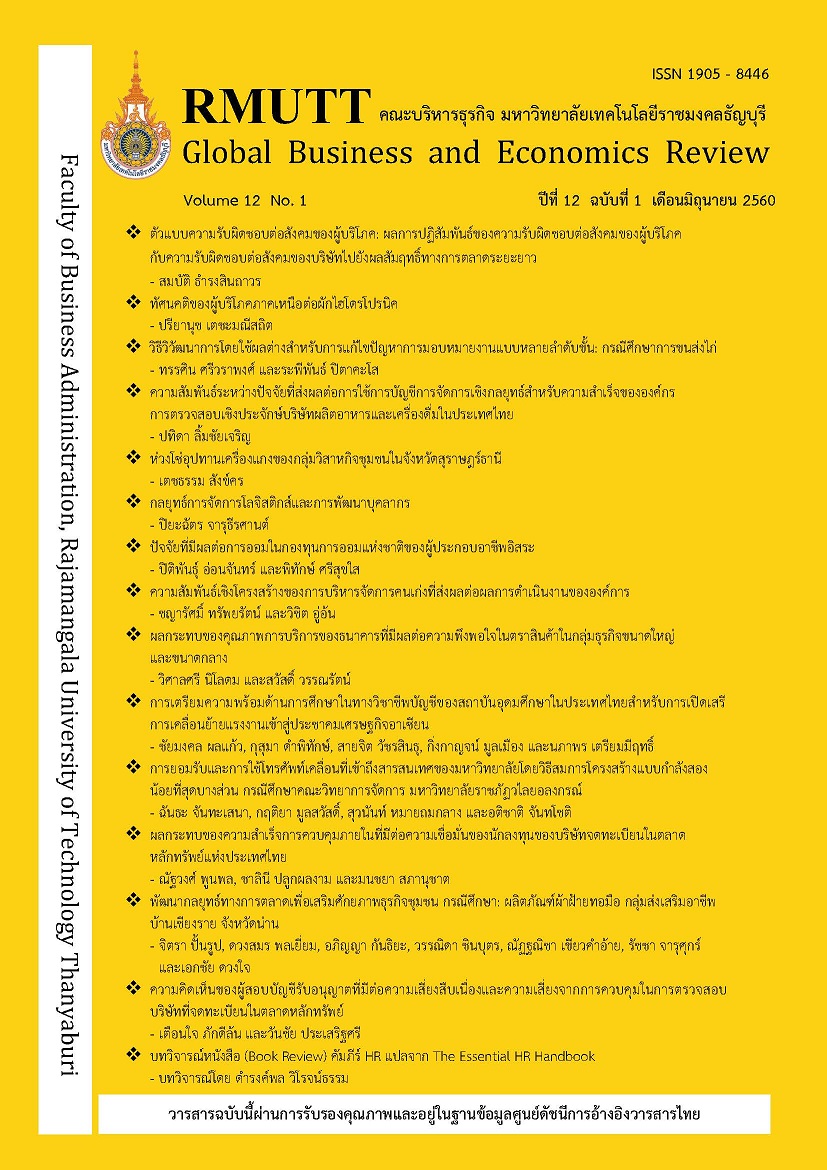CONSUMER ATTITUDES TOWARDS HYDROPONIC VEGETABLES IN NORTHERN THAILAND
Keywords:
Consumer Attitude, Consumer Behaviour, Hydroponic Vegetables, Shopping ExperiencesAbstract
This paper explores the concept of consumer attitudes and relevant behaviour on hydroponic vegetable in Northern Thailand as we hope to promote efficiency modern agricultural methods. Three focus group sessions of 21 participants were created to explore the issues. These participants were asked questions and their views on the topic were discussed. An online survey was conducted. The system automatically deleted responses from participants who were outside northern Thailand. A total of 450 questionnaires (155 males, 285 females) were retained as they were completed by respondents in the northern Thailand region. The main question asked concerned participants’ understanding of hydroponic vegetables. The questionnaire also inquired into how growers and sellers can create product value. Giving information to potential customers about the product can help create a market or increase the market demand for the product. Survey results suggest that, Thai people have a positive attitude towards hydroponic vegetables as they view it as clean as no chemicals and insecticides are used in the production of such products. However, many people still do not know about hydroponic vegetables and fruit, therefore an information campaign could facilitate confidence in the product, and thereby create a greater market share for the product. Moreover, cleanliness, packaging, trust, distribution and promotions are also important factors, which can increase shopping experience for the customer.
References
Azorín, J. M., & Cameron, R. (2010). The application of mixed methods in organisational research: a literature review. Electronic Journal of Business Research Methods, 8(2), 95-105.
Cargill, K. (2015). The psychology of overeating: food and the culture of consumerism. London, New York: Bloomsbury Academic.
Churchill, G. A., Brown, T. J., & Suter, T. A. (2010). Basic marketing research (7th ed.). Mason, OH: South-Western Cengage Learning.
Cochran, W. G. (1977). Sampling Technique (3rd ed.). Canada: John Wiley & Son. Retrieved from http://hbanaszak.mjr.uw.edu.pl/StatRozw/Books/Cochran_1977_ Sampling% 20Techniques.pdf
Fernquest J. (2016, May 4). Pesticides in fruits & vegetables: govt quality mark fails test, Bangkok Post, Retrieved from http://www.bangkokpost.com/learning/learning news/959425/pesticides-in-fruits-vegetables-govt-quality-mark-fails-test
Fernquest, J. (2016, October 7). Fruits & vegetables still have dangerous chemicals, Bangkok Post. Retrieved from http://www.bangkokpost.com/learning/advanced/ 1104820/fruits-vegetables-still-have-dangerous-chemicals
Fowke, J. H., Longcope, C., & Hebert, J. R. (2000). Brassica vegetable consumption shifts estrogen metabolism in healthy postmenopausal women. Cancer Epidemiology and Prevention Biomarkers, 9(8), 773-779. Retrieved from http://popcensus.nso.go.th/quick_stat/Northern_T.pdf
Johnson, G. I., Weinberger, K., & Wu, M. H. (2008). The vegetable industry in tropical asia: Thailand: an overview of production and trade. Retrieved from https://www.researchgate.net/profile/Katinka_Weinberger/publication/242582977_T he_Vegetable_Industry_in_Tropical_Asia_Thailand/links/0deec532d321d9157d00000 0/The-Vegetable-Industry-in-Tropical-Asia-Thailand.pdf
Kiefer, I., Prock, P., Lawrence, C., Wise, J., Bieger, W., Bayer, P., & Rieder, A. (2004). Supplementation with mixed fruit and vegetable juice concentrates increased serum antioxidants and folate in healthy adults. Journal of the American College of Nutrition, 23(3), 205-211.
Kotler, P., & Armstrong, G. (2013). Principles of marketing (15th ed.). London: Pearson.
Kwan, C. Y., Yeung, K. W., & Au, K. F. (2004). Decision making behavior towards casual wear buying: a study of young consumers in mainland China. Journal of Management & World Business Research, 1(1), 1-10.
LaPiere, R. T. (1934). Attitudes vs. actions. Social Forces, 13, 230-237.
National Statistical Office of Thailand. (2016). Key indicators of the population and housing 1990 - 2010: Northern Region. Retrieved from http://web.nso.go.th/en/census/poph/2010/data/bkk_2.keyindicators.pdf
Posri, W., Shankar, B., & Chadbunchachai, S. (2006). Consumer attitudes towards and willingness to pay for pesticide residue limit compliant “safe” vegetables in Northeast Thailand. Journal of International Food & Agribusiness Marketing, 19(1), 81-101.
Resh, H. M. (1993). Hydroponic food production. California: Woodbridge Press Publishing Company.
Rungfapaisarn, K. (2012, March 5). Cashing in on hydroponic vegetables. The nations. Retrieved from http://www.nationmultimedia.com/news/business/corporate/30177234
Sproles, G. B. & Kendall, E. L. (1986), A methodology for profiling consumers' decision-making styles. Journal of Consumer Affairs, 20(2), 267-279.
Thailand Board of Investment. (2015). Thailand’s Food Industry. Retrieve from http://www.boi.go.th/upload/content/BOI_edit_9-8-58_19610.pdf
The Department of Agricultural Extension. (2015). Grow hydroponic vegetables. Retrieved From http://www.servicelink.doae.go.th/corner%20book/book%2005/Hydropronic.pdf
The World Bank (2015, January 26). Urbanisation in Thailand is dominated by the Bangkok urban area. Retrieved form https://www.worldbank.org/en/news/ feature/2015/01/26/urbanization-in-thailand-is-dominated-by-the-bangkok-urban-area
Wattanapreechanon, E. & Sukprasert, P. (2012) Development of soiless culture for crop production in Thailand. Kasetsart Journal, 33, 475-485. Retrieved from http://kasetsartjournal.ku.ac.th/kuj_files/2013/A1301251059260450.pdf)
Wattanapreechanon, E. & Sukprasert, P. (2015). Situation and adoption of soilless culture technology for vegetable production in Thailand. Khon Kaen Agriculture Journal, 43(1), 181-190. Retrieved from http://ag2.kku.ac.th/kaj/ PDF.cfm?filename=19%20Patana.pdf&id=2071&keeptrack=4
Wickliffe, V. P. (2004). Refinement and re-assessment of the consumer decision-making style instrument. Journal of Retailing and Consumer Services, 11(1), 9-17.
Downloads
Published
How to Cite
Issue
Section
License
The articles published in this journal are the intellectual property of their respective authors.
The views and opinions expressed in each article are solely those of the individual authors and do not reflect the positions of Rajamangala University of Technology Thanyaburi or any of its faculty members. All components and content of each article are the sole responsibility of the respective authors. In the event of any errors, the authors shall bear full responsibility for their own work.








